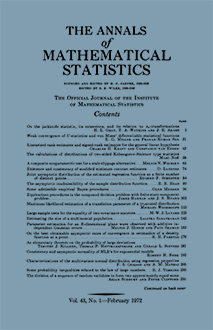Abstract
Let $I$ be the closed unit interval, with the usual topology; II the set of probabilities on $I$, with the weak$^\ast$ topology: $\mu_n \rightarrow \mu$ in II if and only if $\int_I f d\mu_n \rightarrow \int_I f d\mu$ for each continuous, real-valued $f$ on $I$. For $\mu, \nu$ in II, recall that $\mu \equiv \nu$ means: $\mu(A) = 0$ if and only if $\nu(A) = 0$ for all Borel subsets $A$ of $I$. Of course, $\equiv$ is an equivalence relation. The graph of $\equiv$, namely the set of $(\mu, \nu) \varepsilon II \times II$ with $\mu \equiv \nu$, is Borel (2.11 of [2]). One result of this paper is: there is no Borel selector for $\equiv$; that is, there is no Borel subset of II meeting each $\equiv$ class in exactly one point. Let $\Sigma(\equiv)$ be the $\sigma$-field of all Borel subsets of II saturated under $\equiv$, that is, containing with $\mu$ all $\nu \equiv \mu$. If there were a Borel selector for $\equiv$, there would be a Borel function $f$ on II with $f(\mu) = f(\nu)$ if and only if $\mu \equiv \nu$, and $\Sigma(\equiv)$ would be separable. However, (1) Proposition. $\Sigma(\equiv)$ is inseparable. The proof of (1) is based on the following idea of Blackwell. Let $\mathscr{F}$ be a $\sigma$-field, and $P$ a probability on $\mathscr{F}$. Say $P$ is continuous if each $\mathscr{F}$-atom has outer $P$-measure 0, and say $P$ is $0 - 1$ if $P(A) = 0$ or 1 for all $A \varepsilon \mathscr{F}$. (2) Lemma (Blackwell). If $P$ is continuous and $0 - 1, \mathscr{F}$ is inseparable. Thus, (1) follows from (3) Theorem. There is a continuous $0 - 1$ probability on $\Sigma(\equiv)$. Two proofs of (3) will be given in Sections 2 and 4 respectively. Section 3 contains a result on random distribution functions [3], which may be of independent interest, and which is used in Section 4. Section 5 deals with the coarser equivalence relation $\approx$, where $\mu \approx \nu$ means: $\mu(A) = 0$ if and only if $\nu(A) = 0$ for all open subsets $A$ of $I$. Now $\approx$ is induced by a Borel function (3.5 of [2]). More is true: (4) Theorem. There is a Borel selector for $\approx$.
Citation
David A. Freedman. "On Two Equivalence Relations between Measures." Ann. Math. Statist. 37 (3) 686 - 689, June, 1966. https://doi.org/10.1214/aoms/1177699462
Information





